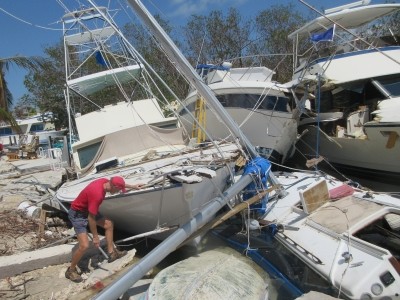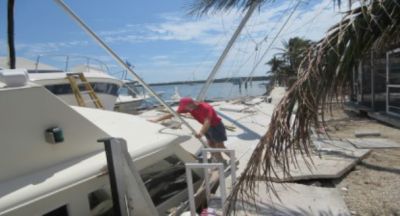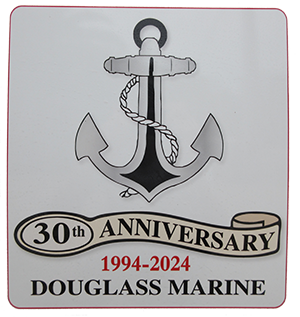Vessel damage claim work continues in the Florida Keys
by Keith Douglass, AMS®
The Article is reproduced from the SAMS Spring 2018 Newsletter
My wife Diane and I have enjoyed living and raising our two daughters in the Florida Keys, since 1990. Following our arrival we have experienced a number of storms, but mercifully the Keys have been spared numerous times; not this time. Since the passage of Hurricane Irma we were allowed to return to our home on Lower Matecumbe Key (Mile Marker 74 Bayside) based on the geographically based phased in return. With no power or cell service those who returned early had to rely on their own resources, and those of their neighbors. Once electrical power was restored the requests to address damaged vessels began for Douglass Marine Company LLC. Thus far, we have inspected nearly 80 commercial and recreational vessels ranging in size from a few personal watercraft to those in excess of 50 ft. Recent statistics state that more than 1,500 vessels in the Florida Keys were salvaged for disposal with many still lining the fairways of a Marathon golf course where previously hundreds of refrigerators, freezers and stoves were stored for disposal. Fortunately, the vast majority of the vessels we were involved with are repairable. The difficulty- lies in obtaining estimates from fiberglass repair technicians, outboard motor and diesel mechanics as well as electronic equipment vendors. Much of the damage we have seen required fiberglass repair work ranging from punctured hulls when a jack stand failed to superstructure damage due to hurricane force winds. Windblown debris littered nearly all the vessels we encountered, leading to corrosion of metal parts.
The worst damage we witnessed and had to investigate occurred in Boot Key Harbor, in Marathon, the site of a large anchorage, mooring field and live-aboard community. Several hundred vessels were either complete total losses (CTLs) or severely damaged. Many vessels were directed to leave protected berths inside the harbor to anchor, or secure to a mooring where the moorings held but their pendants failed in many cases piling vessels into the man-groves and canals on the western shore. Simply getting aboard vessels was a challenge and disposing of the CTLs remains a costly and logistical challenge for local and state officials. Although the storm surge varied depending on location along the island chain, windblown salt spray (WBSS) as we now refer to it, defined as rain laced with salt from the nearby Atlantic, Gulf of Mexico and Florida Bay and mixed with horticultural debris also saltwater laden. The WWSB found its way into lower unit gear casings, covered hulls, homes and about everything else, as the rain blew horizontally across marinas, neighborhoods and businesses.
Like the delayed reaction from a lightning strike where severely energized electrical components are affected, but continue to function for a time then fail weeks or months later, the corrosion caused by the WWSB is having a similar delayed affect. Diane and I inspected a dozen vessels a day during one stretch. The humidity was over 80 percent and the temperature was in the 90’s. Yes, we are used to the humidity and temperature, but the exertion over many hours each day and trying to stay hydrated found me collapsing one morning and a trip to the Mariner’s Hospital ER (embarrassing as I knew well the head of the ambulance crew and another member went to school with our elder daughter). Dehydration I learned can occur over several days, which is what took place. I now wear a”Camelback” like backpack when I can.
Diane and I recognize that we are working in a marine”war zone” and are taking precautions in addition to avoiding dehydration to prevent an accident. We deemed one vessel to be unsafe to board given its location and another located in a severely damaged dry stack building in a Middle Keys marina forced us to call off the inspection until the vessel could be removed from the building and relocated to a safe location. The tools we use are simple, as the need for mobility especially when dealing with multiple vessels in a location.
Basic tools include tape measures, chalk, magnifying glass, phenolic hammer, mirrors and a few others easily carried in a waist pack. Our tool bags with other surveying equipment are nearby in our truck, if needed. Safety equipment we have been using includes rubber gloves, knee pads and safety glasses, when warranted, along with plenty of sunscreen, snacks and a cap.
We have had the pleasure of working with a number of insurance companies, some for the first time and each has made it evident that they were committed to assisting those they insured and gave us the latitude to ensure that each claim was handled efficiently, to allow folks to get back on their feet. It’s remarkable but not surprising to us that folks who just lost their homes are more worried about their boats. Perhaps it’s a Keys thing but we do understand. Maybe it’s time we launch our boat and get aboard again to help bring some sense of normalcy back to our lives as well.




